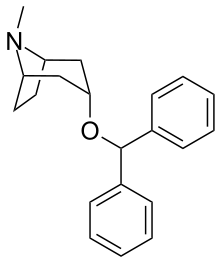Benzatropine
 | |
 | |
| Systematic (IUPAC) name | |
|---|---|
|
(3-endo)-3-(Diphenylmethoxy)-8-methyl-8-azabicyclo[3.2.1]octane | |
| Clinical data | |
| Trade names | Cogentin |
| AHFS/Drugs.com | monograph |
| Pregnancy category |
|
| Legal status |
|
| Routes of administration | Oral, IM, IV |
| Pharmacokinetic data | |
| Metabolism | Hepatic |
| Biological half-life | 12-24 hours |
| Excretion | Urine |
| Identifiers | |
| CAS Number |
86-13-5 |
| ATC code | N04AC01 |
| PubChem | CID 1201549 |
| IUPHAR/BPS | 7601 |
| DrugBank |
DB00245 |
| ChemSpider |
16736541 |
| UNII |
1NHL2J4X8K |
| ChEBI |
CHEBI:3048 |
| ChEMBL |
CHEMBL1201203 |
| Synonyms | Benztropine |
| Chemical data | |
| Formula | C21H25NO |
| Molar mass | 307.429 g/mol |
| |
| |
| | |
Benzatropine (INN), also known as benztropine (USAN, BAN), is an anticholinergic marketed under the trade name Cogentin which is used in the treatment of Parkinson's disease, Parkinsonism, and dystonia.
Medical uses
Benzatropine is an anticholinergic drug used in patients to reduce the side effects of antipsychotic treatment. Benzatropine is also a second-line drug for the treatment of Parkinson's disease. It improves tremor, but not rigidity and bradykinesia. Benzatropine is also sometimes used for the treatment of dystonia, a rare disorder that causes abnormal muscle contraction, resulting in twisting postures of limbs, trunk, or face. In veterinary medicine, benzatropine is used to treat priapism in stallions.[1]
Adverse effects
These are principally anticholinergic:
- Dry mouth
- Blurred vision
- Cognitive changes
- Constipation
- Urinary retention
- Tachycardia
- Anorexia
- Psychosis (in overdose)
While some studies suggest that use of anticholinergics increases the risk of tardive dyskinesia (a long-term side effect of antipsychotics),[2][3] other studies have found no association between anticholinergic exposure and risk of developing tardive dyskinesia,[4] although symptoms may be worsened.[5]
Drugs that decrease cholinergic transmission may impair storage of new information into long-term memory. Anticholinergic agents can also impair time perception.[6]
Pharmacology
Benzatropine is a centrally acting anticholinergic/antihistamine agent. It is a selective M1 muscarinic acetylcholine receptor antagonist. Benztropine partially blocks cholinergic activity in the basal ganglia and has also been shown to increase the availability of dopamine by blocking its reuptake and storage in central sites, and as a result, increasing dopaminergic activity. Animal studies have indicated that anticholinergic activity of benzatropine is approximately one-half that of atropine, while its antihistamine activity approaches that of mepyramine. Its anticholinergic effects have been established as therapeutically significant in the management of Parkinsonism. Benzatropine antagonizes the effect of acetylcholine, decreasing the imbalance between the neurotransmitters acetylcholine and dopamine, which may improve the symptoms of early Parkinson's disease.[7]
Benzatropine analogues are atypical dopamine reuptake inhibitors,[8] which might make them useful for people with extrapyramidal symptoms who take antipsychotics.
Benzatropine also acts as a functional inhibitor of acid sphingomyelinase (FIASMA).[9]
Benzatropine has been also identified, by a high throughput screening approach, as a potent differentiating agent for oligodendrocytes, possibly working through M1 and M3 muscarinic receptors. In preclinical models for multiple sclerosis, benzatropine decreased clinical symptoms and enhanced re-myelination.[10]
See also
References
- ↑ Wilson, DV; Nickels, FA; Williams, MA (1 Nov 1991). "Pharmacologic treatment of priapism in two horses". Journal of the American Veterinary Medical Association: 1183–4.
- ↑ Kane JM, Smith JM (1982). "Tardive dyskinesia: Prevalence and risk factors, 1959 to 1979". Archives of General Psychiatry 39 (4): 473–81. doi:10.1001/archpsyc.1982.04290040069010. PMID 6121548.
- ↑ Wszola BA, Newell KM, Sprague RL (2001). "Risk factors for tardive dyskinesia in a large population of youths and adults". Experimental and Clinical Psychopharmacology 9 (3): 285–96. doi:10.1037/1064-1297.9.3.285. PMID 11534539.
- ↑ van Harten PN, Hoek HW, Matroos GE, Koeter M, Kahn RS (1998). "Intermittent neuroleptic treatment and risk for tardive dyskinesia: Curaçao Extrapyramidal Syndromes Study III". The American Journal of Psychiatry 155 (4): 565–7. PMID 9546009.
- ↑ Yassa R (1988). "Tardive dyskinesia and anticholinergic drugs. A critical review of the literature". L'Encephale 14 (Spec No): 233–9. PMID 3063514.
- ↑ Gelenberg AJ, Van Putten T, Lavori PW, Wojcik JD, Falk WE, Marder S, Galvin-Nadeau M, Spring B, Mohs RC, Brotman AW. (1989). "Anticholinergic effects on memory: benztropine versus amantadine.". Clinical Psychopharmacology 9 (3): 180–5. doi:10.1097/00004714-198906000-00004. PMID 2661606.
- ↑ MIMS Australia Pty Ltd. MIMS.
- ↑ Hiranita T, Kohut SJ, Soto PL, Tanda G, Kopajtic TA, Katz JL. (2014). "Preclinical efficacy of N-substituted benztropine analogs as antagonists of methamphetamine self-administration in rats". J Pharmacol Exp Ther. 348 (1): 174–91. doi:10.1124/jpet.113.208264. PMC 3868882. PMID 24194527.
- ↑ Kornhuber J, Muehlbacher M, Trapp S, Pechmann S, Friedl A, Reichel M, Mühle C, Terfloth L, Groemer T, Spitzer G, Liedl K, Gulbins E, Tripal P (2011). "Identification of novel functional inhibitors of acid sphingomyelinase". PLoS ONE 6 (8): e23852. doi:10.1371/journal.pone.0023852. PMC 3166082. PMID 21909365.
- ↑ Deshmukh VA, Tardif V, Lyssiotis CA, Green CC, Kerman B, Kim HJ, Padmanabhan K, Swoboda JG, Ahmad I, Kondo T, Gage FH, Theofilopoulos AN, Lawson BR, Schultz PG, Lairson LL. (2013). "A regenerative approach to the treatment of multiple sclerosis". Nature 502 (7471): 327–332. doi:10.1038/nature12647. PMID 24107995.
| ||||||||||||||||||||||||||||||||||||
| ||||||||||||||||||||||||||||||||||||||||||||||||||||||||||||||||||||||||||||||||||||||||||||||||||||||||||||||||||||||||||||||||||||||||||||||||||||||||||||||||||||||||||||||||||||||||||||||||||||||||||||||||||||||
| ||||||||||||||||||||||||||||||||||||||||||||||||||||||||||||||||||||||||||||||||||||||
| ||||||||||||||||||||||||||||||||||||||||||||||||||||||||